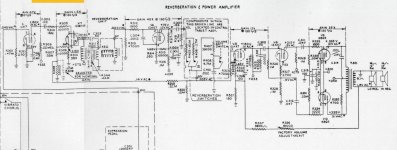I'm trying to help a friend repair a Hammond Organ AO-43 amplifier that uses a paralleled section 12BH7 to drive a reverb tank with a 14 Henry plate choke as the plate load instead of a resistor. The original choke has gone open. Will a choke intended for use as a DC supply filter work as a replacement? I simply don't know if there are major design differences between chokes intended for use in CLC filters and chokes intended for plate loads. The overall specs on this Hammond Mfg. part appear similar enough:
https://www.mouser.com/ProductDetail/Hammond-Manufacturing/157L?qs=o/sL%2BddUClXXlG/JFsor3Q==
Before someone points on that 14H doesn't seem enough for full range signal drive, that's what it says on the schematic. I suspect that one purpose of the choke is less gain at lower frequencies, which is a good thing in reverb drive unless you want a lot of muddy reverb.
And this is a reverb amp, not HiFi, so we don't have to worry about perfect fidelity. It just needs to be good enough to get the job done.
https://www.mouser.com/ProductDetail/Hammond-Manufacturing/157L?qs=o/sL%2BddUClXXlG/JFsor3Q==
Before someone points on that 14H doesn't seem enough for full range signal drive, that's what it says on the schematic. I suspect that one purpose of the choke is less gain at lower frequencies, which is a good thing in reverb drive unless you want a lot of muddy reverb.
And this is a reverb amp, not HiFi, so we don't have to worry about perfect fidelity. It just needs to be good enough to get the job done.
Do you have a schematic that allows you to estimate the maximum current through the choke? This would be helpful in selecting a replacement. Otherwise, you may get by by simply weighing the existing choke and selecting one of a similar inductance and similar (or greater) weight.
It's a reverb. How bad can it be?
In very broadband work we would worry about resonances at the top of the audio band. Big lump of iron will want to ring at less than 100kHz. But rarely as low as 5kHz. And reverb doesn't need to go that high.

At the low end, a triode is forgiving. 15H at 50Hz is 4K which is about what that dual fat triode acts-like.
In very broadband work we would worry about resonances at the top of the audio band. Big lump of iron will want to ring at less than 100kHz. But rarely as low as 5kHz. And reverb doesn't need to go that high.

At the low end, a triode is forgiving. 15H at 50Hz is 4K which is about what that dual fat triode acts-like.
Last edited: